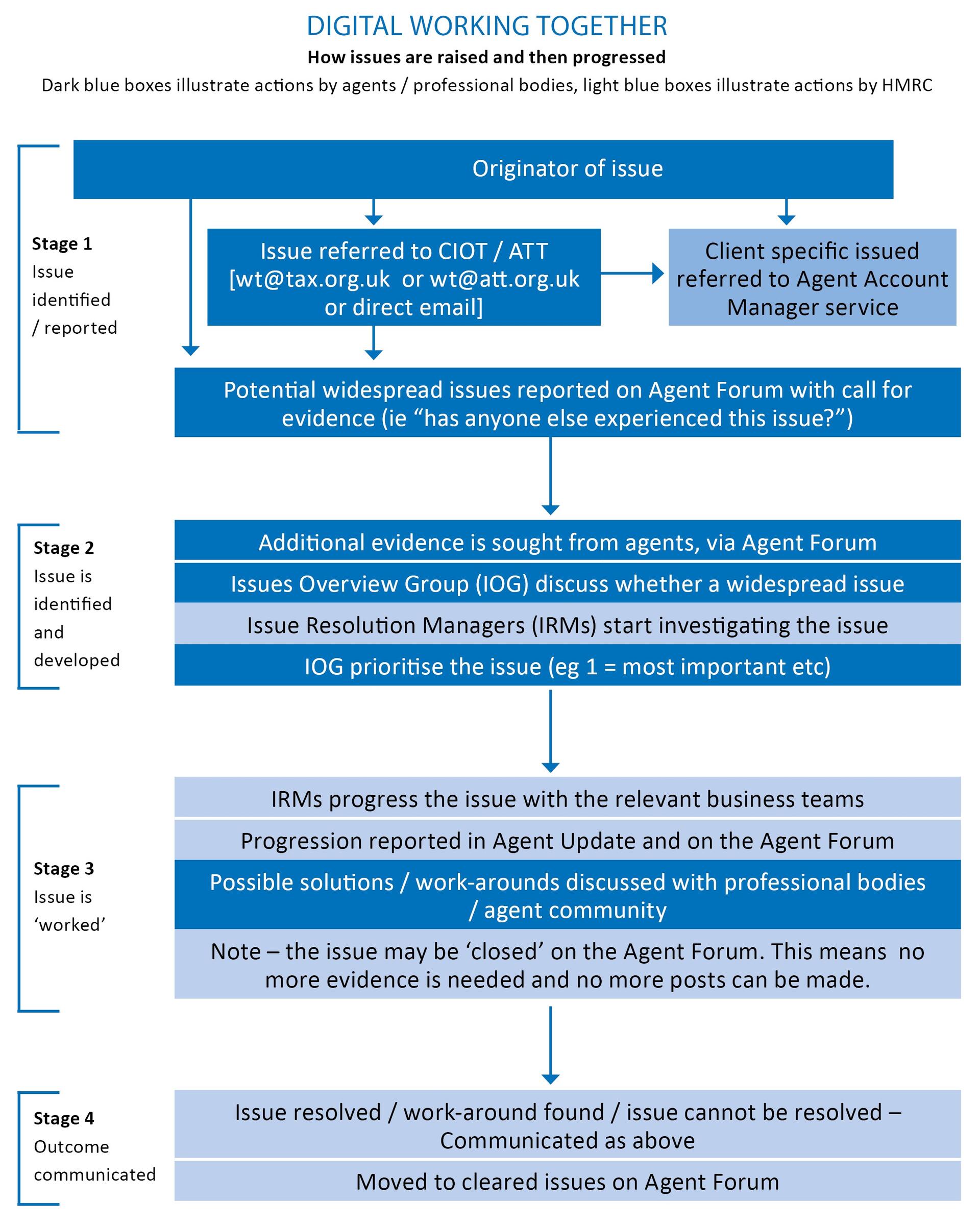OMG, it’s IOG

Jon Stride provides an look at the activities of the Issues Overview Group of the CIOT, and how it can help members in practice
Key Points
What is the issue?
The IOG is a partnership involving the professional bodies of the tax world and HMRC.
What does it mean to me?
Both ATT and CIOT are actively involved with HMRC to resolve operational issues identified and reported by the tax profession – particularly through the Agents Forum.
What can I take away?
A great deal of time and effort is devoted to progressing and resolving systemic difficulties by the PB representatives and HMRC.
Acronyms are used for just about everything these days. Ask someone to name a three letter acronym ending in the letter G and it is likely that the answer will be OMG. However, as far the relationship between HMRC and the professional bodies are concerned, there is another answer – IOG.
So, what is the IOG? Probably the best way to answer that is to take a couple of steps back, and to see what the role of IOG is.
In my previous article in the February 2017 edition of Tax Adviser I wrote about Working Together – this is the link between HMRC and the tax profession. In my article I mentioned that there were many Working Together groups dotted around the country – and with the demise of the tax offices to which they were attached, the local groups folded.
The IOG exists to take the matters identified at Working Together one step further – and in particular progress those issues with HMRC and to ensure that the systemic errors raised by Working Together are investigated and (hopefully) to enable those problems to be advanced so that enhancements to HMRC system and processes can be introduced.
In order to understand how the IOG came into existence, we need to step back in time to 2005, when the Inland Revenue and the Customs and Excise were amalgamated to form HM Revenue and Customs (HMRC). At about this time, HMRC invited nominated nominated agents from the accountancy professional bodies when they formed NWTT – National Working Together Team. There had always been a Working Together Steering Group, who had an overarching view of the issues raised and the potential to escalate matters that were considered urgent. In addition to the involvement of the professional bodies, WTSG also had two HMRC secondees.
At this time, a Working Together publication was issued to agents – this later became ‘Agent Update’, and this is how it is still known.
NWTSG was disbanded about five years ago. However, it was agreed by all parties that there remained a clear need to collate, review and escalate the systemic issues raised by the local Working Together groups to the NWTT, and monitor the subsequent reporting back of issues to local Working Together Coordinators.
In response to this need, the Issues Overview Group was formed. IOG met for the first time in September 2013. Membership of the group was drawn from the representative bodies that sat on NTWSG, and members of the HMRC NWTT team. The following were agreed for IOG:
- IOG will meet quarterly, by telephone, and for an hour
- The professional bodies will have up to two representatives each on IOG
- HMRC will be represented by 2 or 3 from the previous NWTT committee
- Management information on referrals, issues raised, and issues closed will be circulated at least a week before the meeting. These will be discussed by exception.
- The IOG will not discuss the detail of any individual case
- The focus of the group will be the delivery of service, reviewing challenges to closing a referral, finding evidence to progress referrals.
- Unresolved issues from IOG to be escalated through JISG
A key aspect of the IOG was that it was expected to strengthen links between national and local Working Together coordinators. The IOG members devised a scoring spreadsheet to weight the reported issues, with ranking depending on the impact, gravity and where necessary to escalate those with far-reaching significance.
Subsequent developments within IOG
In the months shortly after the formation of IOG the local Working Together Groups ceased to exist. The only way to refer the matters that would have normally been escalated through the local groups was for matters to be referred to the various professional bodies, and then on to IOG. Both ATT and CIOT have maintained dedicated e-mail in boxes for Working Together matters.
There have therefore been changes to the way that IOG operates as a result – but the core activity of the group remains to bring problems arising at the coalface to the attention of HMRC, and where ever possible to achieve solutions or work arounds.
It was inevitable that the local Working Together groups would disappear as the local tax offices to which they were attached closed. HMRC recognised the need to produce something that would keep those members of the tax profession in touch with those that were previously involved with local Working Together onboard. The Digital Working Together webinars were launched to fill the gap. It is fair to say that these were not a great success – those working out in the field had enjoyed the camaraderie and ability to discuss issues with both similar professionals and HMRC that Working Together provided.
HMRC recognised that the members of IOG worked well together, and as a result, were asked to host the Digital Working Together webinars. The members agreed to this – but only as an interim measure.
Although the members of the group were happy to do this, it did add significantly to the workload, adding to the existing schedule of teleconferences and meetings that already existed.
And up to the present day – the Working Together Forum
The arrival of the Forum in 2017 marked the arrival of a new method of working. Although introduced gradually, this has brought a new way for those members that have logged into the Forum to report problems, and to add comments where necessary.
Both the IOG members and HMRC are able to see the problems being reported, and to use these when discussing the issues that need to be resolved. An article written by Richard Wild appeared in the October edition of Tax Adviser. This provides useful insight into how to get involved.
The IOG members have a teleconference roughly every six weeks to discuss the matters and problems in hand – with one or two 90 minute teleconferences between the members representing the professional bodies, with a further 90 minute teleconference with HMRC to discuss existing issues, new issues and emerging problems. This gives plenty of opportunity for lively debate.
The meetings are chaired for HMRC by Hugh McCann, from Customer Experience and Stakeholder Engagement at HMRC. From the agent community, all of the key professional bodies are represented – in addition to those at Artillery House, AAT, ACCA, ICAEW and ICAS are represented, as are CIMA. HMRC provide the secretariat for the meetings involving them.
Each professional body can have two representatives on the committee – which for ATT and CIOT means that there is one member of the technical team from Artillery House (Helen Thornley and Richard Wild respectively), and two members from practice, who are working at the coalface, and are dealing with HMRC on a practical basis day in and day out (myself and Nigel Clarke respectively). Having the input of practitioners means that we are able to stress the way in which problems are affecting those trying to take care of their clients tax affairs.
Solutions are rarely swift – sometimes there is no solution, but we aim to work with HMRC in order to produce a solution wherever possible. Being able to discuss matters in an open and frank manner with HMRC enables the group to share not only their concerns, but also suggestions for improving or resolving a particular problem or issue.
The IOG, in conjunction with other committees that liaise with HMRC such as the Virtual Communications Group (VCG) and the Joint Initiatives Steering Group (JISG) are key to ensuring that the door remains open in discussing matters with HMRC. With HMRC operations being increasingly centralised, and contact at a local level being a distant memory, the use of the Working Together Forum and the involvement of IOG represent the best avenue available for the profession to deal with day to day problems involving HMRC.
The article written by Noel Flanagan that appeared in the November 2017 edition of Tax Adviser provides a helpful summary of how and why agents should be involved with the Working Together Forum.
Richard Wild from CIOT has produced a helpful flowchart showing how Working Together issues are progressed, which is reproduced here.

How can IOG help members in practice?
This is a two way process – how can members in practice help IOG? The key to the operation of IOG is that members of the professional bodies report difficulties involving HMRC at operational level by using the Working Together Forum.
If there is an issue that is likely to be systemic and not specific to one client, use the Forum to report it. If a problem is affecting you at ground level, it is quite possible that others are affected. Use the Forum to see if others are experiencing similar problems. If the issue isn’t there, raise it as a potential issue. If HMRC don’t know about an issue, they can’t be expected to do anything about it!
And the future?
The Working Together Forum is up and running, and as this beds in, there will be other opportunities for IOG. One particular change that is being considered is for members of IOG to be involved with bespoke HMRC Talking Points presentations, where a particular matter that the group has been looking at needs further public discussion. The members of IOG welcome the fact that they are able to have frank and open discussions with HMRC, and look forward to being able to continue to do so.
An example of the issues that the IOG have been involved with is the ongoing problems with P800 calculations. We have been able to illustrate the type of errors filtering through – and provide examples of the impact of those errors. By establishing common themes emerging with the errors, it enables HMRC to address those specific aspects.
Being able to discuss matters directly with HMRC enables us not only to provide details of the problem but also of its ramifications for agents, taxpayers, and the likely extent of the issue. Following the highlighting of one particular issue with P800’s, HMRC were able to identify those cases that were likely to be subject to errors in that field, and to suspend the issue of P800’s to those taxpayers until the problem had been fixed – a move that was helpful to all those involved.
There is some common ground with other groups involving the profession and HMRC, and in recent weeks IOG and the VCG (Virtual Communications Group) have both been involved with meeting with HMRC where there is common ground, thus helping with resolving issues.
The role of the Issues Overview Group in relation to the Forum is becoming clearer now and we can revert to our core role of recognising the most serious issues, as well as following issues through from reporting to resolution, including escalation.
Many thanks to Jeremy Nottingham (Chair of the IOG) and Jacqueline Colston-Stewart from HMRC for their help in providing background details for this article.


